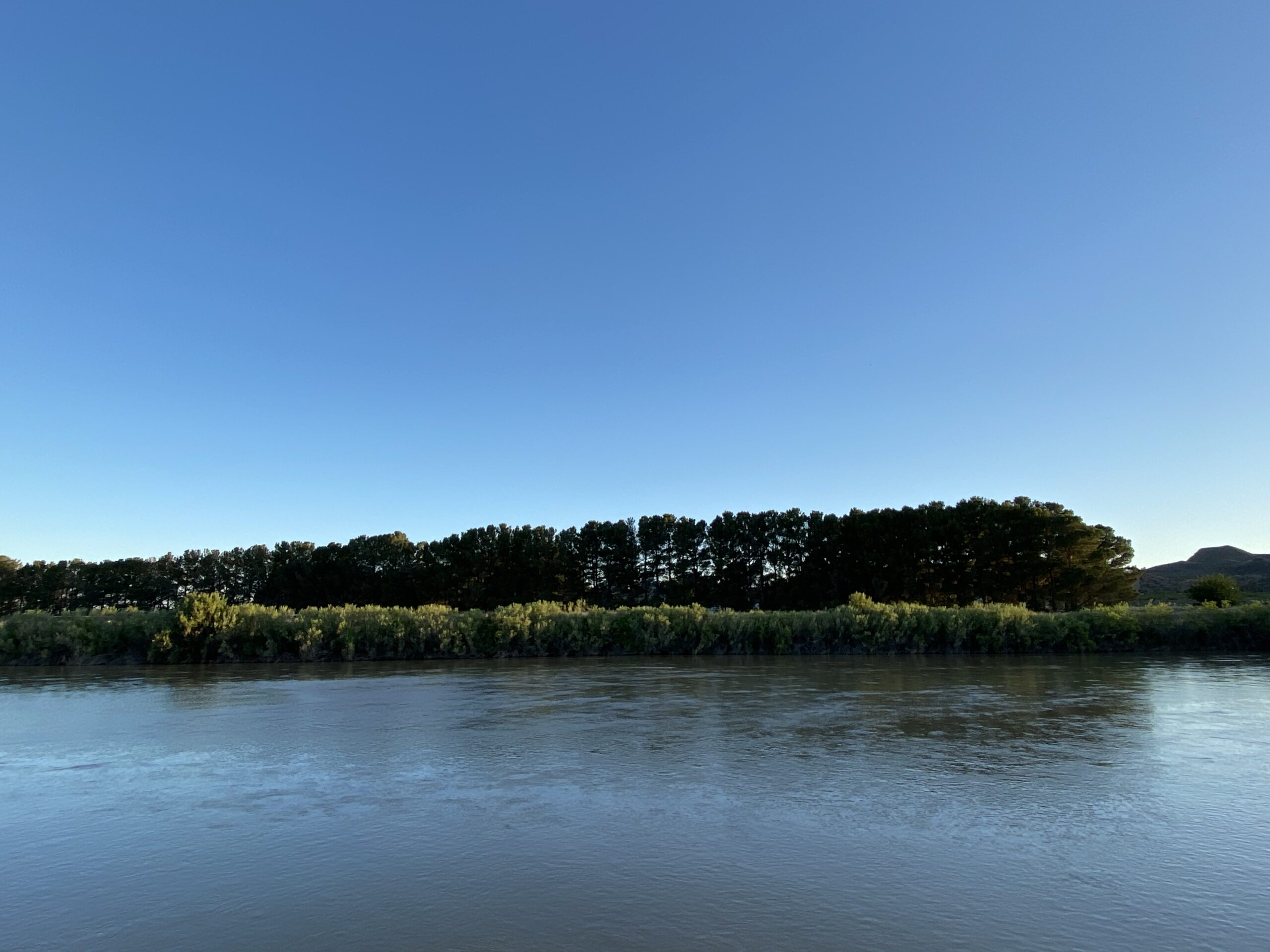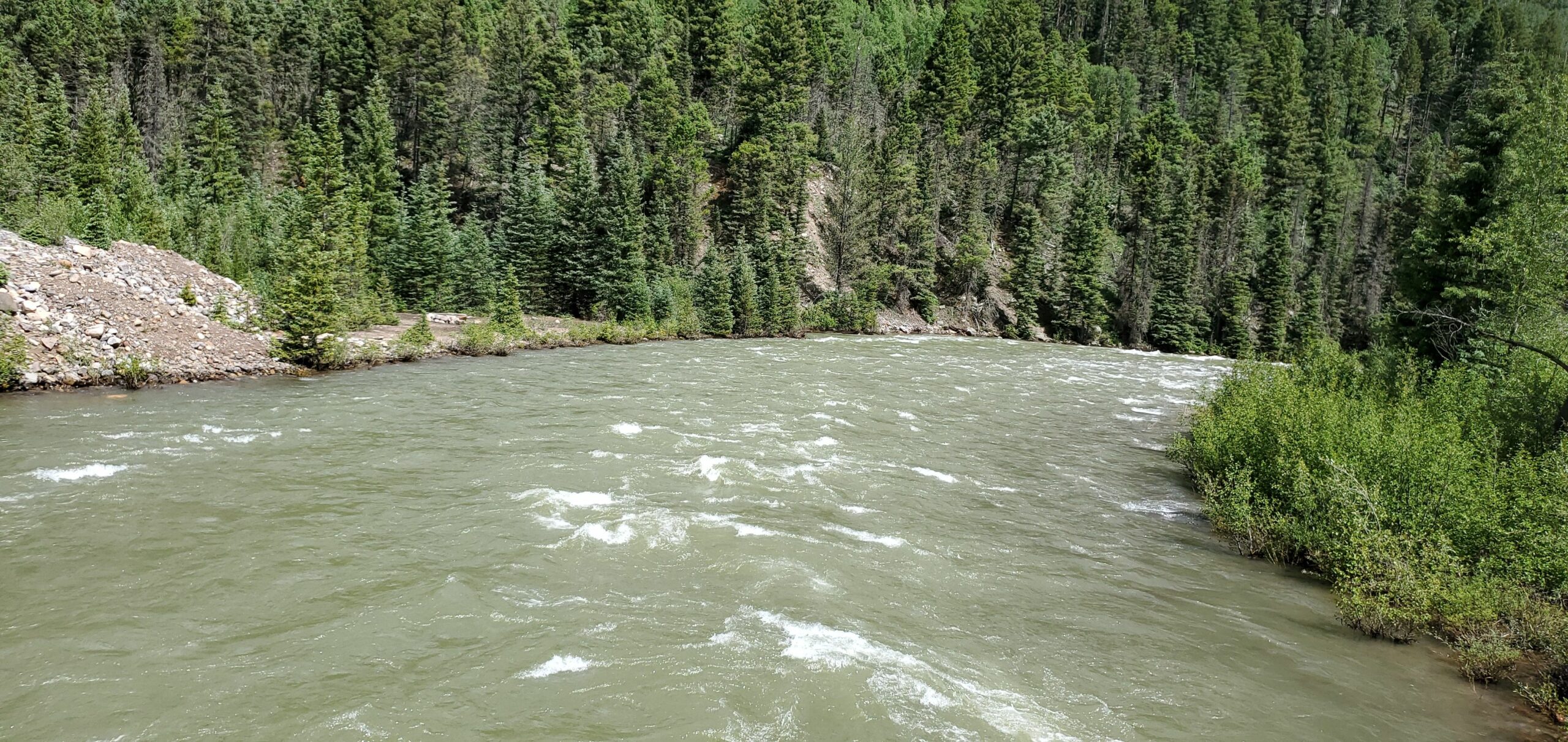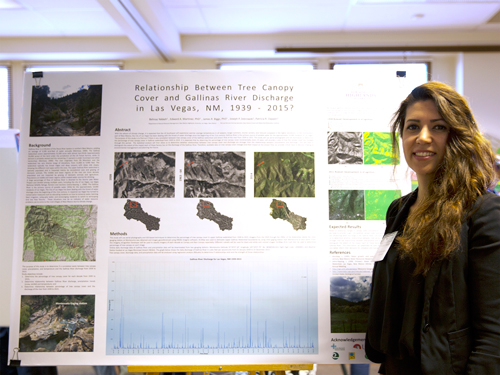COMMUNITY WATER & WATERSHED MANAGEMENT
Sustainable Water and Agriculture Life Cycle Assessment Project

The purpose of this project is to connect academic research with the practical needs of the pecan industry in the Mesilla Valley. This opportunity opens the possibility of learning about the current industry practices.
Dona Ana County Watershed Master Conservationist Program

The Doña Ana Soil and Water Conservation District was awarded a grant from the New Mexico Association of Conservation Districts to create a Watershed Masters program designed in the spirit of the NMSU volunteer Master Gardener program. Doña Ana Soil and Water Conservation District (DASWCD) and partners: NMSU Extension, New Mexico Water Resources and Research Institute, Elephant Butte Irrigation District, and Dona Ana Flood Commission will create an annual, sustainable volunteer program and develop the curriculum.
NM WRRI Announces 2019 Student Water Research Grants
NM WRRI received 24 proposals in response to the 2019 Student Water Research Grant Request for Proposals ‒ 20 from New Mexico State University, two from New Mexico Tech, one from the University of New Mexico, and one from New Mexico Highlands University. Funding for 13 grants were made with state appropriations and three grants were made with Bureau of Reclamation-New Mexico State University Cooperative Agreement funding.
Johnson Adio, Natural Resources Management, NMHU, MS; (Dr. Jennifer Lindline) Water Quality Monitoring and Assessment of the Rio Mora at the Rio Mora National Wildlife Refuge, Mora County, NM
Isuru Sachitra Abeysiriwardana Arachchige, Civil Engineering, NMSU, PhD; (Dr. Nirmalakhandan) Domestic Wastewater Treatment Using Algal Systems in Winter Climate
Alireza Bandegi, Chemical & Materials Engineering, NMSU, PhD; (Dr. Reza Foudazi) Electrochemical-Assisted Ultrafiltration Membranes for Simultaneous Removal of As, Cd and Cr
Hengameh Bayat, Chemical & Materials Engineering, NMSU, PhD; (Dr. Umakanta Jena) Wastewater Treatment Using Food Waste Char Obtained from Hydrothermal Liquefaction as a Low-Cost Adsorbent Material
Victoria Blumenberg, Animal & Range Sciences, NMSU, PhD; (Dr. Amy Ganguli) Stable Isotope Analysis to Determine the Usefulness of Surface Water as a Proxy for Precipitation in a Semi-Arid, Mountainous Environment
Moticha M. Franklin, Chemistry & Biochemistry, NMSU, BS; (Dr. Antonio S. Lara) Surface Area of a Local Clay Material to Elucidate Uranium Abatement for Potable New Mexico Water Management
Alyssa Latuchie, Economics, UNM, PhD; (Dr. Janie Chermak) A Survey: New Mexicans’ Willingness to Pay for Produced Water Treatment for Beneficial Re-Use
Kimberly McNair, Biology, NM Tech, MS; (Dr. Linda DeVeaux) Tracking CRE in the Rio Grande: Determining Correlation Between the Appearance of Antibiotic Resistant Bacteria in Surface Waters and Local Infection Rates
Esmaiil Mokari, Plant & Environmental Sciences, NMSU, PhD; (Dr. Manoj Shukla) Developing a 2/3D Model for Improving Fertigation Scheduling Under Salinity Stress for Pecan
Srimali Preethika Munasinghe-Arachchige, Civil Engineering, NMSU, PhD; (Dr. Nirmalakhandan) Assessment of Disinfection Byproducts (DBPs) Formation in Algae-Treated Wastewater for Safer Reuse in Unrestricted Applications
Juliano Penteado de Almeida, Civil Engineering, NMSU, PhD; (Dr. Pei Xu) Enhanced Water Recovery and Membrane Scaling Mitigation for Desalination Using Innovative Electromagnetic Field (EMF) and 3D Printed Open Flow Channel Membranes
Jackson Powers, Plant & Environmental Sciences, NMSU, MS; (Dr. Ryan Goss) Herbicide Phytotoxicity Under Drought Conditions in Warm and Cool Season Turfgrass
Madeline Richards, Earth & Environmental Sciences, NM Tech, MS; (Dr. Daniel Cadol) Modeling Rainfall-Runoff Relationships in Conjunction with Sediment Transport Measurements in Ephemeral Channels
Michael Whiting (Gaurav Jha, student mentor), Geology, NMSU, MS; (Dr. April Ulery) Monitoring Toxic Metal Uptake by Corn Grown in Agricultural Fields Across Animas and San Juan Rivers
Jiuling Yu, Chemical & Materials Engineering, NMSU, PhD; (Dr. Hongmei Luo) Wasterwater-Treatment Algae-Derived Hydrochar for Heavy Metal Adsorption and Recycling
Muchu Zhou, Chemical & Materials Engineering, NMSU, PhD; (Dr. Reza Foudazi) Design of Optimized Produced Water Treatment Units for the Agricultural Irrigation
NMSU Graduate Student Investigates the Use of Plants to Remove Contaminants from the Gold King Mine Spill of Wastewater Into the Animas and San Juan Rivers
By Catherine Ortega Klett, NM WRRI Program Manager
Jason Fechner is a graduate student in the NMSU Department of Plant and Environmental Sciences. He graduated in May 2018 with a BS in horticulture from NMSU. Jason received a 2018 NM WRRI Student Water Research Grant entitled: Gold King Mine Spill: Contaminant Removal of San Juan County Rivers via Phytoremediation.
The Gold King Mine Spill in 2015 contaminated the Animas and San Juan Rivers with heavy metals that affected multiple states including Colorado, New Mexico, and Utah. This event had a tremendous impact on local farmers dependent on the Animas and San Juan Rivers for irrigation of their crops. There are also health concerns related to the plant and aquatic life in and around the contamination sites. Due to these concerns, remediation of these contaminated mining sites and river stretches is a priority issue. The main objective of this project is to explore the use of selected plants and their associated microbes for the removal and/or stabilization of contaminants deposited by the mine spill event. In this effort, Jason is working under the guidance of his faculty sponsors Dr. April Ulery, Department of Plant and Environmental Sciences, and Dr. Soum Sanogo, Department of Entomology, Plant Pathology, and Weed Science at NMSU.
Common duckweed (Lemna minor) is the plant chosen for this remediation project, as it is found throughout the United States and is known for its remediation ability as well as its high reproductive rates. It is an aquatic plant that grows on still or shallow, slowly moving waterways, and it is known to tolerate water contaminated with various toxins. For the Gold King Mine spill, there are multiple heavy metal contaminants of interest; however, the focus of the present study is the uptake of iron. Iron is one of the principal contaminants carried by the spill, and while it can be very toxic in high doses, it is also of interest because of its ability to form stable complexes (chelates) with other, more toxic contaminants. Accordingly, the focus of this project is to determine the extent to which duckweed is able to remove iron from an aquatic system. An attendant goal is the identification of bacterial and fungal species that are associated with the duckweed and may be partially or largely responsible for the chelation of iron.
To date, duckweed has been grown in various small vats under controlled conditions of lighting as well as nutrient and iron concentrations. Associated bacterial and fungi cultures have been isolated, grown, and samples analyzed using the genetic multiplication process known as polymerase chain reaction (PCR). The study results indicate that three different species of fungus are present, including Alternaria alternata, Plectosphaerella cucumerina, and Cladosporium tenuissimum. A review of the literature suggests that Alternaria alternata is most likely responsible for the plant’s iron uptake ability, as it can mycosynthesize iron nanoparticles.
A future, additional avenue of research for this project will include setting up the experiment again, but on a larger scale, composting the duckweed once the experimental trial is over, and growing Pleurotus ostreatus (oyster mushrooms) using the duckweed compost. The oyster mushrooms will be analyzed to see whether the fruiting bodies have absorbed any of the iron. If they do absorb iron, there will be an effort to determine how much is absorbed, how much is bound in the compost, and how much may have precipitated out of solution.
Knowledge of what types of plants can be used to remove or stabilize spill contaminants could prove very beneficial for water research and environmental agencies, especially since this approach is environmentally friendly, relative to conventional remediation methods. It is also potentially very cost effective, since it would reduce the burden of removal of contaminated material.
A native of Alamogordo, NM, Jason indicated that the NM WRRI grant has afforded him the opportunity to work with other scientists and to get their perspective on similar research. He has also been able to observe other field research studies underway on the Gold King Mine spill. He said, “The grant has provided funding for laboratory and other supplies pertaining to my research. After completing a master’s degree, I plan to continue my education and obtain a PhD. Eventually I want to work for a research university where I can train the next generation of scientists in the classroom and the lab.”
NMDSWB Future Scenario Visualizations - River Basins
NMDSWB Future Scenario Visualizations - River Basins
New Mexico Water Budget Model Enhanced to Include Future Scenarios (continued)
With the updated structural changes, the future portion of the model is able to incorporate scenario inputs. The three preliminary inputs that have been developed are:
- Climate Change
- Population Growth
- Efficiency
Climate change is the main driver of the model moving forward. It incorporates four separate climate emission scenarios based on three Global Circulation Model (GCM) runs. This scenario provides the precipitation, surface water flows, and temperature for the future portion of the model. Population growth can be altered from the predicted population change to determine the effects of public and domestic water use. The efficiency metrics allow for a change in either agricultural efficiency or human use efficiency again to examine the impacts of water use on the overall water budget at different spatial resolutions. These scenarios allow a user to create a specific future scenario based on a combination of parameters that are of interest.
The preliminary future scenario tool was presented to the Interstate Stream Commission on March 17, 2017 to showcase how the NMDSWB can be used as a tool for water planners, users, and scientists in New Mexico. The NMDSWB is still in development, continuing to improve on these current scenarios, integrating other research from the SWA, and incorporating new scenarios. The online web model that runs the historic water budget model is being enhanced to include the new future NMDSWB model and corresponding scenarios.
Project collaborators include Jesse Roach (PE, PhD) and Ken Peterson (MS), Tetra Tech Inc.; Bruce Thomson (PhD), UNM; Vince Tidwell (PhD), Sandia National Laboratories, and Joshua Randall (MS), NM WRRI, and Austin Hanson (BS), NM WRRI.
NMSU Professor Working to Remove Water Pollutants (continued)
Unbeknownst to the engineers at the time, the treatment process to destroy the fuel residues created trace amounts of NDMA in the water, Brewer said. “In the 1980s, NASA became aware of the NDMA and other organic pollutants in the water underneath WSTF,” Brewer said. “Since then, they have been pumping up the water, treating it and re-injecting it underground.”
Brewer said the treatment process will likely need to be continued over the next century with thousands of gallons per day, requiring much electricity and costing a great deal. “The purpose of this project is to see if we can make activated carbons out of pecan shells that can adsorb the NDMA out of the water as effectively but for a lower cost,” Brewer said.
Brewer said the project started two years ago and is currently in the analytical method development stage—measuring NDMA concentrations in water at the part per trillion level. “After that, the remaining time of the three-year project will be spent designing the adsorption water treatment system using the pecan shell activated carbons,” Brewer said.
The NSF grant is for Brewer to research a water desalination system that uses heat from burning bio-waste, such as pecan shells, pecan orchard prunings, cotton gin trash and yard waste. The system design is intended to reduce the effects of scaling, a common problem when desalinating water, especially in this region, Brewer said.
In addition to these two projects, Brewer has also been the principal investigator for five other projects, funded by the Sun Grant Program South Central Region, the NMSU-Bureau of Reclamation Cooperative Agreement, the Western Excelsior Corporation, NASA and the USDA. These five projects have received more than $574,000 in funding.
“On every project, I have worked with researchers from multiple colleges, multiple institutions, and industry,” Brewer said. “As a land-grant institution, NMSU is well-suited for this kind of research as it is easy to pull together the needed expertise from basic science, applied agricultural science, engineering and extension. I am very grateful for the wonderful collaborators I have found here.”
Posters Again a Highlight of Annual Conference (continued)

The NM Office of the State Engineer along with federal agency U.S. Geological Survey, and programs such as the Bosque Ecosystem Monitoring Program and the Canadian River Riparian Restoration Project participated. Several posters were presented by the private sector including Hawley Geomatters, NV5 Inc, Swanson Geoscience, and Tetra Tech, Inc.
Sandia National Laboratories has been very generous in its financial support of the poster session over many years and NM WRRI is grateful for their continued sponsorship.
Click here to view poster abstracts of research presented at the NM WRRI annual water conference.
